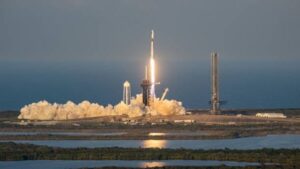In the latest chapter of the commercial space race, Amazon is preparing to make an audacious entry into orbit with a $20 billion initiative aimed at challenging Elon Musk’s Starlink. Named Project Kuiper, this ambitious venture could reshape the global internet landscape and redefine how the world connects.
Amazon, a company synonymous with e-commerce dominance, cloud computing, and smart home devices, is now turning its attention skyward. Project Kuiper represents one of the most significant investments in the company’s history and a bold attempt to stake its claim in the burgeoning satellite internet industry.
The Race for Space-Based Internet
The idea of providing internet access via satellites is not new. However, rapid advancements in rocket technology, miniaturization of satellites, and declining launch costs have made it a commercially viable reality only in recent years.
Elon Musk’s SpaceX has been a pioneer in this sector with Starlink, a constellation of over 5,500 operational satellites providing high-speed internet across more than 60 countries. Launched in 2019, Starlink aims to address the digital divide by delivering connectivity to rural and underserved areas worldwide. It already boasts over 2 million subscribers and has made a significant mark in both consumer and enterprise markets.
Now, Amazon seeks to disrupt this dominance.
What is Project Kuiper?
Named after the Kuiper Belt — a region of the solar system beyond Neptune filled with icy bodies — Amazon’s Project Kuiper plans to launch over 3,236 low-Earth orbit (LEO) satellites. These satellites will form a sprawling network designed to beam internet service directly to homes, businesses, and government clients around the world.
The project promises high-speed, low-latency internet, with a focus on regions where traditional fiber optic and cellular networks are limited, unreliable, or prohibitively expensive.
Amazon has already secured regulatory approval from the Federal Communications Commission (FCC) for the satellite constellation, with a condition to deploy at least half of the satellites by July 2026.
A $20 Billion Commitment
Amazon’s investment in Project Kuiper isn’t just substantial — it’s historic. The company has committed $20 billion to develop, launch, and maintain the Kuiper network. This covers everything from manufacturing the satellites to developing ground-based infrastructure, customer terminals, and deploying them via multiple launch providers.
To bolster this effort, Amazon has inked the largest commercial launch contract in history, securing up to 92 rocket launches across three major partners: United Launch Alliance (ULA), Arianespace, and Jeff Bezos’ own Blue Origin. Notably, Blue Origin will use its upcoming New Glenn rocket, marking a significant milestone for Bezos’ private aerospace venture.
Competition Heats Up
While Starlink currently enjoys a first-mover advantage, Amazon is banking on its global infrastructure, cloud expertise, and massive financial resources to close the gap.
Unlike SpaceX, which largely depends on its proprietary Falcon 9 and Starship rockets, Amazon’s strategy leverages a diversified launch portfolio, reducing dependency on a single provider and mitigating operational risks.
Moreover, Amazon plans to integrate Project Kuiper with its AWS (Amazon Web Services) ecosystem. This could open new opportunities for cloud-based satellite services, enterprise solutions, and edge computing applications, potentially offering a unique value proposition that Starlink hasn’t fully explored.
Market Potential
The global satellite internet market is projected to grow exponentially in the coming decade. According to estimates by Allied Market Research, the industry could exceed $50 billion by 2030. This growth is driven by increasing demand for reliable, high-speed connectivity in remote areas, rising data consumption, and the emergence of Internet of Things (IoT) applications.
Amazon’s entry with Project Kuiper not only intensifies the competitive landscape but also validates the long-term commercial viability of satellite-based broadband.
Besides SpaceX, other players like OneWeb, Telesat, and China’s StarNet are also vying for a share of this expanding market. However, few can match the scale, ambition, and financial muscle that Amazon brings to the table.
The Road Ahead
Amazon’s first two prototype satellites — KuiperSat-1 and KuiperSat-2 — were successfully launched into orbit in late 2024 aboard a United Launch Alliance rocket. Initial tests have reportedly gone well, demonstrating key systems like satellite communications, ground station links, and customer terminal connectivity.
The company plans to begin mass satellite production at its newly built Kuiper satellite production facility in Kirkland, Washington. Full-scale deployments could commence as early as mid-2025, with beta services expected by 2026.
Amazon has also revealed plans for an affordable, compact customer terminal — priced at around $400, compared to Starlink’s $599 kit — designed to appeal to a broad range of users, including households in emerging markets.
Challenges and Risks
Despite its promise, Project Kuiper faces several hurdles. Technological challenges related to satellite performance, launch delays, regulatory compliance, and space traffic management loom large. Furthermore, achieving cost-effective global coverage while ensuring reliable service and minimizing latency remains a complex undertaking.
Starlink’s head start, rapidly growing subscriber base, and in-house launch capabilities present formidable competition. Moreover, public perception and geopolitical factors could influence how these networks are adopted in different regions.
Conclusion
Amazon’s $20 billion bet on Project Kuiper marks one of the most consequential moves in the modern space economy. As the battle for orbital dominance heats up, the world stands to benefit from increased connectivity, competition, and innovation.
While Starlink may currently lead the way, the entry of a tech titan like Amazon ensures that the race is far from over. If successful, Project Kuiper won’t just connect the unconnected — it could redefine the very infrastructure of the global internet.







